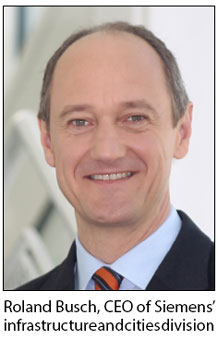Siemens pitches disaster systems
Updated: 2013-04-19 11:15
By Michael Barris in New York (China Daily)
|
||||||||
China would save billions of yuan by investing in "flexible" rail, traffic and building-management systems that could withstand disasters, an executive of German engineering giant Siemens AG said on Thursday.
Roland Busch, CEO of Siemens' Infrastructure and Cities Sector, told a media gathering in New York that technology is crucial to "resilient and efficient" protection of infrastructure. By incorporating resiliency into planning, investment and maintenance of its infrastructure, Busch said, a city can reduce potential damage, enhance productivity and create a safe place to live.
"We can't prevent natural disasters", but with knowledge and technology "we can better protect our infrastructures", he told reporters on hand for the presentation of initial results from a report on resilient infrastructure. That concept envisions "a city that is better protected and at the same time more efficient and reliable".

Siemens, along with the Regional Plan Association, an urban-research group in the New York-New Jersey-Connecticut region, and UK-based engineering and consulting firm Arup, produced a report on how cities can "better protect themselves" against natural disasters like Hurricane Sandy.
Sandy, which ravaged parts of New Jersey's Atlantic shore and New York City in October, caused $50 billion in damage, nearly a third of the total worldwide damage related to natural disasters in 2012.
Siemens, which has 30,000 employees in China, has been working with the country's leadership to help safeguard national infrastructure against future disasters such as the 7.9-magnitude earthquake in Sichuan province in May 2008 that killed about 70,000 people.
In 2011, Siemens and the Chinese government renewed a memorandum of understanding, signed in 1985, with the goal of supporting China's sustainable development. Its activities in China include working with China Southern Power Grid to supply components for two high-voltage direct current lines - Nuozhadu-Guangdong (5,000 megawatts and Xiluodu-Guangdong (6,400 mW). It also has supplied advanced systems for subway lines in Shanghai, Wuhan, Xi'an, and other cities.
Siemens is "looking into particular technologies that are more suitable for the Chinese environment," Busch said. "Yet I have to say that the problems [for all countries] are almost the same." The findings of this study "can be transferred to any other city", he said.
The executive stressed that cities around the globe would minimize the impact of natural disasters by investing in software for rail automation and the management of traffic, buildings and evacuations, making these systems "more flexible and easier to control and coordinate" than the ones now in use.
michaelbarris@chinadailyusa.com

 In Photos: 7.0-magnitude quake hits Sichuan
In Photos: 7.0-magnitude quake hits Sichuan
 Li Na on Time cover, makes influential 100 list
Li Na on Time cover, makes influential 100 list
 FBI releases photos of 2 Boston bombings suspects
FBI releases photos of 2 Boston bombings suspects
 World's wackiest hairstyles
World's wackiest hairstyles
 Sandstorms strike Northwest China
Sandstorms strike Northwest China
 Never-seen photos of Madonna on display
Never-seen photos of Madonna on display
 H7N9 outbreak linked to waterfowl migration
H7N9 outbreak linked to waterfowl migration
 Dozens feared dead in Texas plant blast
Dozens feared dead in Texas plant blast
Most Viewed
Editor's Picks

|

|

|

|

|

|
Today's Top News
Live report: 7.0-magnitude quake hits Sichuan, heavy casualties feared
Boston suspect cornered on boat
Cross-talk artist helps to spread the word
'Green' awareness levels drop in Beijing
Palace Museum spruces up
First couple on Time's list of most influential
H7N9 flu transmission studied
Trading channels 'need to broaden'
US Weekly

|

|







